Virtua Tennis: World Tour Review
Virtua Tennis: World Tour
Sega has updated its tennis classic for a handheld generation. Is this the best PSP game so far?
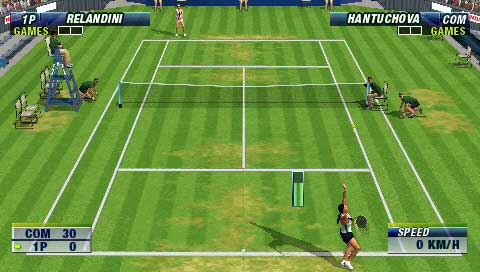
Verdict
Key Specifications
- Review Price: £30.00
”’Platforms:”’ PSP
There are two very good reasons why I’ve been excited at the prospect of playing Virtua Tennis: World Tour on my PSP. First up is that along with Crazy Taxi and Soul Caliber, Virtua Tennis was one of my all time favourite Dreamcast games. And as anyone who owned a Dreamcast will tell you, it was a console awash with Grade A titles, so making the top three is no mean feat.

The second reason that I’ve been looking forward to playing Virtua Tennis is that my wife is in it! No, really, she is. In case you’re thinking that this review is going to descend into some lame fantasy about being married to a tennis star, I can assure you it’s not. But I can also assure you that right there, on the player select screen, I have the choice of selecting (or not) my wife. Now, I’ll let you guess which one of the (female in case you were wondering) players has to put up with me every day, but I’ll give you a clue, it’s not Maria Sharapova – I just couldn’t put up with those grunts and screams all day long.
So, now that I’ve got the novelty of seeing the woman I married in a video game out of my system, let’s move onto the game itself and the big question at hand – Does it live up to the Virtua Tennis legacy? The simple answer is yes, while the more qualified answer is HELL YES! But before I tell you just why this game is so good, and why you would be certifiably insane not to have it in your collection, I have to cover my one major gripe.
If you’ve been keeping abreast of PSP news over the past few months you’ll know that there have been some interesting developments in the “home brew” scene. Developments such as making the PSP emulate other gaming systems and running said emulated games from a MemroyStick. Of course Sony hasn’t been too happy about its firmware being compromised and has launched several updates over the year. But I’m very much of the “if it ain’t broke, don’t fix it” camp and have been happily running version 1.0 of the PSP firmware that came with my first generation Japanese unit.
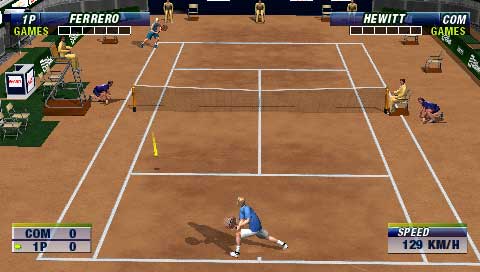
Unfortunately, it seems that Sony is well aware that some users have just not bothered to download the firmware update, and has decided to force our hands, so to speak. I realised this when I loaded the Virtua Tennis UMD into my PSP and was promptly told that I could not play the game until I’d updated my firmware to version 1.52! Now this put me in a tough position – I hate being told what I have to do and part of me just wanted to refuse to load the firmware update, but of course an equally big part of me couldn’t wait to play the game.
It’s pretty obvious from the fact that you’re reading this review that I succumbed and loaded the update, but not without protest! But as if being forced into a firmware update isn’t bad enough, you can’t actually perform the update without the PSP plugged into the mains – so, if I’d taken my PSP with me to the shops and bought this game, I wouldn’t have been able to play it until I got home. Now, this isn’t the first time that Sony has tried to slip a Trojan firmware pony into your PSP, but it is the first time that an update has been required for a game that’s worth playing.
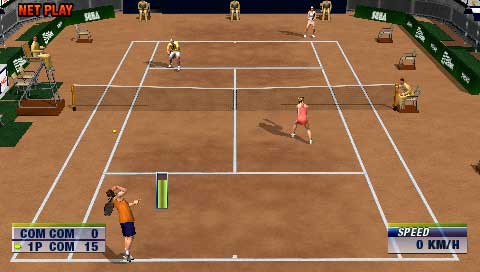
I’m not going to blame Sega for the compulsory update, since I’m fairly certain that the orders came from the Sony mother ship. And, to be fair, any European or US PSP consoles will already have the updated firmware. I guess there aren’t that many people left like myself, that were still running the original firmware, so the problem isn’t a huge one – but I just don’t like being forced into things.
The most important thing to remember here though is that even a little gripe about civil liberties can’t change the fact that this is one of the best, most addictive and downright playable handheld games ever to hit the street.
I’ve had my PSP for around nine months now and I’ve been treated to some awesome handheld gaming during that time. The likes of Ridge Racers, WipeOut Pure and FIFA have all blown me away and had me constantly reminding myself that I was playing on a handheld console. But Virtua Tennis: World Tour takes the PSP up a notch, and leaves you wondering if you are ever going to switch your PS2 and Xbox on again.
As with previous Virtua Tennis games, what makes World Tour so brilliant is its simplicity. This is a game that you can just pick up and play without any previous knowledge and enjoy every second. Of course you may only find each game lasting a matter of seconds, because although the gameplay is simple, the game itself is far from easy.
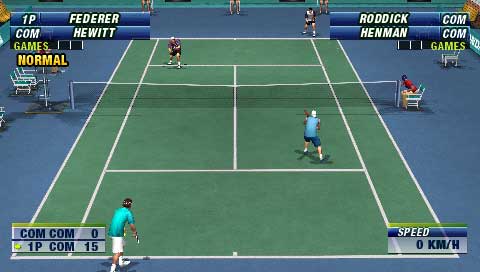
The simplicity I speak of is very apparent in the control method. Movement can be controlled via the D-Pad or the analogue stick, while the X button will give you a topspin stroke, the O button a backspin stroke and the Square button a lob. That’s pretty much it, except it’s not. Not only do you have three different shot buttons, moving the analogue stick or D-Pad while striking the ball will determine where your shot is placed. Add to this the fact that you can apply varying degrees of power depending on your timing when striking the ball, and you’ve got a hell of a lot to think about in a split second – a little bit like playing tennis one might say!
You’ll soon find out that the “simple” gameplay becomes a lot more complicated when you play your first tournament. You might cruise past the first few opponents, but when you reach the Semi-Final things start to get tough. But it’s when you reach the final that you realise how much you still have to learn – not only will your opponent play almost perfect strokes, his footwork will be light and fast and he’ll have an almost psychic ability to judge where you’re going to play the ball. After replaying the final a dozen or so times, you’ll come to realise that some training is in order.
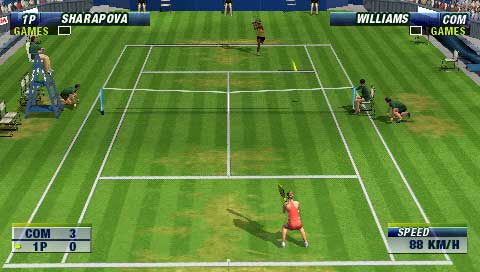
Luckily for you Sega has thrown a handy little career mode into the mix, where you have to build your player up in order for him/her to dominate the World Tour of the title. You can increase the skill of your player by entering a plethora of mini games that are designed to improve every aspect of your game – you can improve your serve by knocking down skittles, sharpen up your footwork by grabbing flags while balls are fired at you, or even practice your volleys by hitting balls onto a target on the ground.
Not only do the training games in the career mode improve your character’s attributes for the World Tour, but it also improves your general playing skills – something that’s invaluable if you want to walk away victorious from a tournament final.
But you don’t need to enter the World Tour in order to take a break from match action. There’s also a “Ball Games” section where you can throw your racquet at challenges like block smashing or balloon popping – this may not sound like much fun, but it really, really is. It’s like all those little sub-games that Nintendo always throws into its Mario and Zelda titles – they don’t really push the game or the story on, but they’re always horribly addictive. Once again though, playing these games will also help you hone your skills for the court.
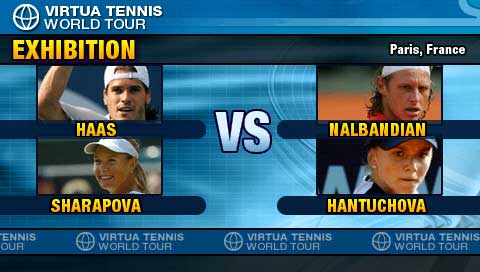
I remember reading reviews of Virtua Tennis on the Dreamcast and the general opinion was that Sega had been pretty stingy with the licensing budget – there was a lack of top rank players on offer. The same criticism can’t be levelled at World Tour, where you’ve got just about every big name on display – Federer, Roddick, Hewitt, Sharapova, Venus Williams and Davenport to name but a few. Obviously Tiger Tim is thrown in to keep us Brits happy, but if his recent Wimbledon and US Open performances are anything to go by, you might be best off avoiding him.
If you do ever get bored of playing singles matches, you can try your hand at doubles. Doubles play adds a whole new dimension to the game and can also produce some ridiculously fast rallies. Of course you are somewhat dependant on how good your computer controlled partner is, but on the whole he covers his area and will leave you to cover yours.
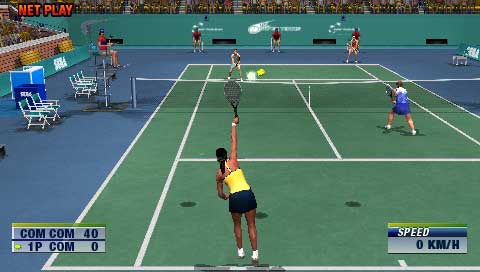
But anyone who played the Dreamcast game will know that it was the multiplayer aspect that really made it special, and Sega has made sure that this shines through with World Tour as well. Not only can you hook up with a friend and play a head to head match, you can actually get together with three other players for some doubles action. Unfortunately I wasn’t able to find three other PSP owners, all with Virtua Tennis to try this out, but I can only imagine that it would be a hysterical way to pass a few hours.
I haven’t even mentioned the graphics yet, which is surprising considering how good they are. The player movement is great, the ball is easily visible no matter how fast it’s moving, and line calls are easy to see when the ball strikes the ground. The stadiums are also beautifully rendered and although there are no official stadium licenses, it’s pretty clear what each one is meant to be. The action replays are still there from previous versions (although the computer seems to get far more replays than you do) and there’s a great split screen view of the players returning to their ends after a rally that appears sometimes – small details, but ones that give the game a true quality feel.
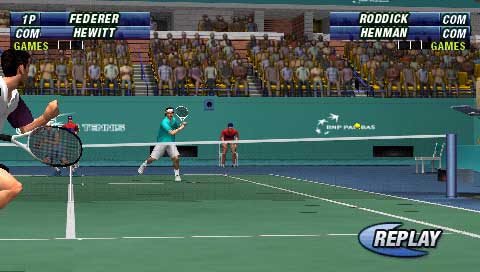
Sound is also first rate, and the effects are perfect without getting in the way of the gameplay. The sounds when you strike the ball reflect the type of shot you played, and the power behind it. The crowd reacts convincingly to the play, and better shots receive a more hearty reception than unforced errors. If there’s one problem with the sound, it’s the rather poor “techno” style soundtrack that accompanies the matches – do yourself a favour and turn this off straight away, the matches are far better without the music.
Despite the dodgy in-match music, general presentation is first rate, with easy to navigate and beautifully designed menus and the ability to customise things like the umpire language. In fact the only fly in the ointment on the presentation front is the slight pause before the umpire announces the score, but to be fair this is something that most PSP games suffer from to varying degrees – so far FIFA seems to be the worst culprit.
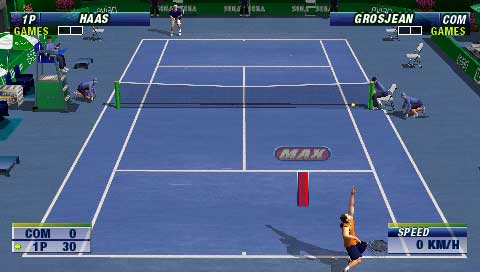
European gamers have had to wait a very long time for the PSP to arrive, but the upside of this situation is that there is a plethora of great games on offer from day one. But even surrounded by some truly excellent launch titles, Virtua Tennis: World Tour shines the brightest – if you’re buying a PSP, don’t even think about leaving the shop without this game.
”’Verdict”’
Virtua Tennis: World Tour is the best PSP game to date – it really is that simple. European gamers may have had to wait an age for the PlayStation Portable, but at least they’re getting a truly brilliant launch title thrown into the bargain.

